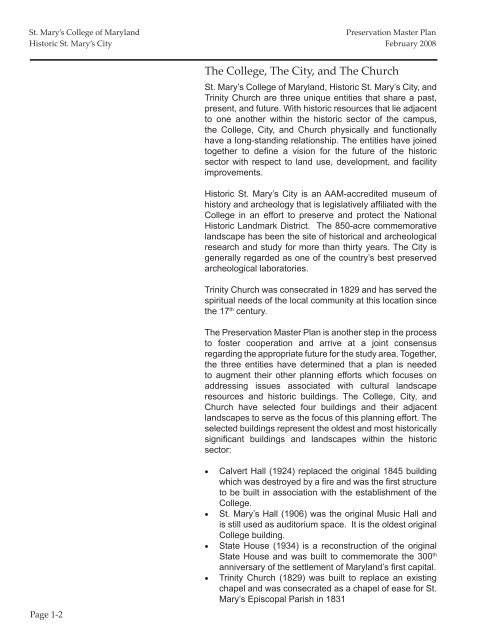St. Mary's College of Maryland Preservation Master Plan
St. Mary's College of Maryland Preservation Master Plan
St. Mary's College of Maryland Preservation Master Plan
- No tags were found...
You also want an ePaper? Increase the reach of your titles
YUMPU automatically turns print PDFs into web optimized ePapers that Google loves.
<strong>St</strong>. Mary’s <strong>College</strong> <strong>of</strong> <strong>Maryland</strong><strong>Preservation</strong> <strong>Master</strong> <strong>Plan</strong>Historic <strong>St</strong>. Mary’s City February 2008The <strong>College</strong>, The City, and The Church<strong>St</strong>. Mary’s <strong>College</strong> <strong>of</strong> <strong>Maryland</strong>, Historic <strong>St</strong>. Mary’s City, andTrinity Church are three unique entities that share a past,present, and future. With historic resources that lie adjacentto one another within the historic sector <strong>of</strong> the campus,the <strong>College</strong>, City, and Church physically and functionallyhave a long-standing relationship. The entities have joinedtogether to define a vision for the future <strong>of</strong> the historicsector with respect to land use, development, and facilityimprovements.Historic <strong>St</strong>. Mary’s City is an AAM-accredited museum <strong>of</strong>history and archeology that is legislatively affiliated with the<strong>College</strong> in an effort to preserve and protect the NationalHistoric Landmark District. The 850-acre commemorativelandscape has been the site <strong>of</strong> historical and archeologicalresearch and study for more than thirty years. The City isgenerally regarded as one <strong>of</strong> the country’s best preservedarcheological laboratories.Trinity Church was consecrated in 1829 and has served thespiritual needs <strong>of</strong> the local community at this location sincethe 17 th century.The <strong>Preservation</strong> <strong>Master</strong> <strong>Plan</strong> is another step in the processto foster cooperation and arrive at a joint consensusregarding the appropriate future for the study area. Together,the three entities have determined that a plan is neededto augment their other planning efforts which focuses onaddressing issues associated with cultural landscaperesources and historic buildings. The <strong>College</strong>, City, andChurch have selected four buildings and their adjacentlandscapes to serve as the focus <strong>of</strong> this planning effort. Theselected buildings represent the oldest and most historicallysignificant buildings and landscapes within the historicsector:Page 1-2• Calvert Hall (1924) replaced the original 1845 buildingwhich was destroyed by a fire and was the first structureto be built in association with the establishment <strong>of</strong> the<strong>College</strong>.• <strong>St</strong>. Mary’s Hall (1906) was the original Music Hall andis still used as auditorium space. It is the oldest original<strong>College</strong> building.• <strong>St</strong>ate House (1934) is a reconstruction <strong>of</strong> the original<strong>St</strong>ate House and was built to commemorate the 300 thanniversary <strong>of</strong> the settlement <strong>of</strong> <strong>Maryland</strong>’s first capital.• Trinity Church (1829) was built to replace an existingchapel and was consecrated as a chapel <strong>of</strong> ease for <strong>St</strong>.Mary’s Episcopal Parish in 1831
















